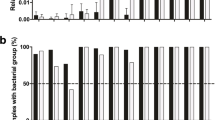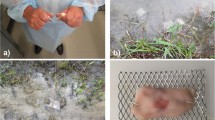Abstract
In the past, it was almost impossible for forensic scientists to separate DNA from an undefined number of different individuals in mixed stains where, for example, two or more suspects had handled the same weapon. Such samples often contain complex mixtures with the consequence of ambiguous or inconclusive mixed DNA profiles. Using the method described of comprehensive and/or targeted screening of shed cells adhering to tapings of garments or objects enables such stains to be individualized. To evaluate the method, 500 microscopically selected single skin flakes were analyzed using two different commercial STR kits to compare the success rates for each PCR typing system. The method has been validated for use in routine casework and has been shown to be rapid, sensitive, and reproducible. It can be predicted that many cases in the archives with body tapings, which have not yet been examined will benefit from this new or perhaps more appropriate, reanimated, technical development, and of particular importance are serious crimes, the so-called cold cases. The remarkable forensic value of this simple but time-consuming technique is exemplified by 2 out of approximately 100 cases already successfully solved using this approach.




Similar content being viewed by others
References
Zamir A, Springer E, Glattstein B (2000) Fingerprints and DNA: STR typing of DNA extracted from adhesive tape after processing for fingerprints. J Forensic Sci 45:687–688
von Oorschot RAH, Jones MK (1997) DNA fingerprints from fingerprints. Nature 387:767
Wiegand P, Kleiber M (1997) DNA typing of epithelial cells after strangulation. Int J Legal Med 110:181–183
Wiegand P, Kleiber M (2001) Less is more—length reduction of STR amplicons using redesigned primers. Int J Legal Med 114:285–287
Coticone SR, Oldroyd N, Philips H, Foxall P (2004) Development of the AmpFISTR SEfiler PCR amplification kit: a new multiplex containing the highly discriminating ACTBP2 (SE33) locus. Int J Legal Med 118:224–234
Mulero JJ, Chang CW, Lagace RE, Wang DY, Bas JL, McMahon TP, Hennessy LK (2008) Development and validation of the AmpFISTR MiniFiler PCR Amplification Kit: a MiniSTR multiplex for the analysis of degraded and/or PCR inhibited DNA. J Forensic Sci 53:838–852
Taberlet P, Griffin S, Goossens B (1996) Reliable genotyping of samples with very low DNA quantities using PCR. Nucleic Acids Res 24:3189–3194
Gill P, Whitaker J, Flaxman C, Brown N, Buckleton J (2000) An investigation of the rigor of interpretation rules for STRs derived from less than 100 pg of DNA. Forensic Sci Int 112:17–40
Findlay I, Taylor A, Quirke P, Frazier R, Urquhart A (1997) DNA fingerprinting from single cells. Nature 389:555–556
Butler JM, Shen Y, McCord BR (2003) The development of reduced size STR amplicons as tools for analysis of degraded DNA. J Forensic Sci 48:1054–1064
Müller K, Klein R, Miltner E, Wiegand P (2007) Q8—a short amplicon multiplex including the German DNA database systems. Forensic Sci Int Genet 1:205–207
T.F.S. Regulator, Response to Professor Brian Caddy's Review of the Science of Low Template DNA Analysis. 2008. Available from: http://police.homeoffice.gov.uk/news-and-publications/publication/operational-policing/Review_of_Low_TemplateDNA_1.pdf?view=Binary
Caragine T, Mikulasovich R, Tamariz J, Bajda E, Sebestyen J, Baum H, Prinz M (2009) Validation of testing and interpretation protocols for low template DNA samples using AmpFLSTR Identifiler. Med J 50(3):250–267
Gill P, Buckleton J (2010) A universal strategy to interpret DNA profiles that does not require a definition of low-copy-number. Forensic Sci Int Genet 4:221–227
Author information
Authors and Affiliations
Corresponding author
Rights and permissions
About this article
Cite this article
Schneider, H., Sommerer, T., Rand, S. et al. Hot flakes in cold cases. Int J Legal Med 125, 543–548 (2011). https://doi.org/10.1007/s00414-011-0548-7
Received:
Accepted:
Published:
Issue Date:
DOI: https://doi.org/10.1007/s00414-011-0548-7




